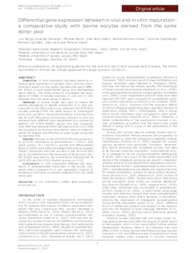Differential gene expression between in vivo and in vitro maturation: a comparative study with bovine oocytes derived from the same donor pool.
Differential gene expression between in vivo and in vitro maturation: a comparative study with bovine oocytes derived from the same donor pool.
Autoria: CAMARGO, L. S. de A.; MUNK, M.; SALES, J. N.; WOHLRES-VIANA, S.; QUINTAO, C. C. R.; VIANA, J. H. M.
Resumo: Objective: In vitro maturation has been shown to influence gene expression in oocytes, but a common shortcoming in reports on the matter has been the use of different donors in each experimental group thus disregarding donor effects. This study aimed to investigate the abundance of mRNA in oocytes matured in vivo and in vitro obtained from the same group of donors. Methods: A bovine model was used to assess the relative abundance of specific transcripts in in vitro-matured (IN VITRO-OPU) and in vivo-matured (IN VIVO-OPU) oocytes collected from the same donors by transvaginal ovum pick-up (OPU). Transcript abundance in oocytes from the IN VIVO-OPU group and oocytes matured in vitro but retrieved from different cows slaughtered at a commercial abattoir (IN VITRO-Abattoir group) was also compared. Total RNA was extracted from denuded oocytes and cDNA was produced via reverse transcription using an oligo(dT) primer for relative quantification of eight target transcripts by real-time PCR. Results: Oocytes in the IN VITRO-OPU group had lower (p<0.05) abundance of peroxiredoxin 1 (Prdx1), heat shock protein 70.1 (Hsp70.1), growth and differentiation factor 9 (Gdf9), and maternal antigen that embryo requires (Mater) transcripts than the oocytes in the IN VIVO-OPU group, all obtained from the same pool of donor cows. Similar results were seen in the comparisons involving the IN VIVO-OPU and IN VITRO-Abattoir groups (p<0.05). Conclusion: In vitro maturation affected the abundance of polyadenylated transcripts in the oocyte cytoplasm when compared to in vivo maturation induced by exogenous hormones in oocytes collected from the same donor pool.
Ano de publicação: 2019
Tipo de publicação: Artigo de periódico
Palavras-chave: Gene expression, In vivo maturation, MRNA, Ovum pick-up
Observações
1 - Por padrão são exibidas publicações dos últimos 20 anos. Para encontrar publicações mais antigas, configure o filtro ano de publicação, colocando o ano a partir do qual você deseja encontrar publicações. O filtro está na coluna da esquerda na busca acima.
2 - Para ler algumas publicações da Embrapa (apenas as que estão em formato ePub), é necessário ter, no celular ou computador, um desses softwares gratuitos. Sistemas Android: Google Play Livros; IOS: iBooks; Windows e Linux: software Calibre.
Acesse outras publicações
Acesse a Base de Dados da Pesquisa Agropecuária (BDPA) para consultar o acervo completo das bibliotecas da Embrapa.

